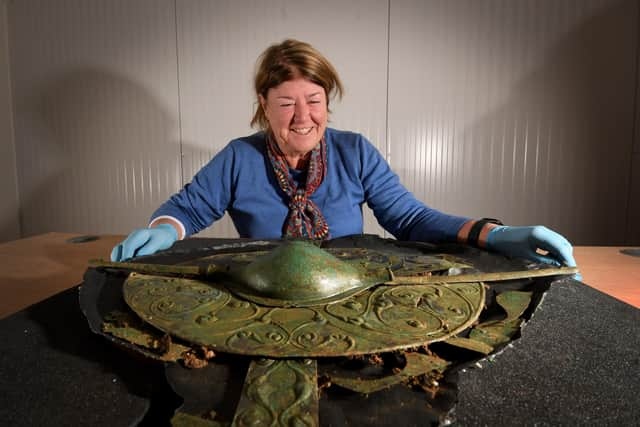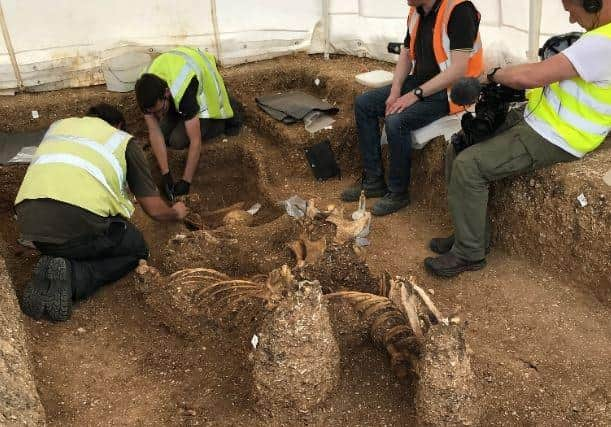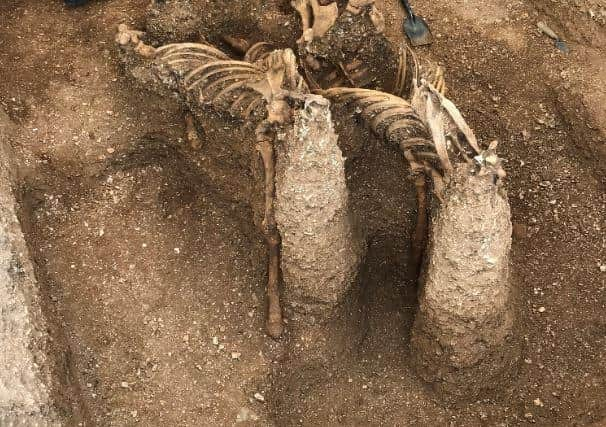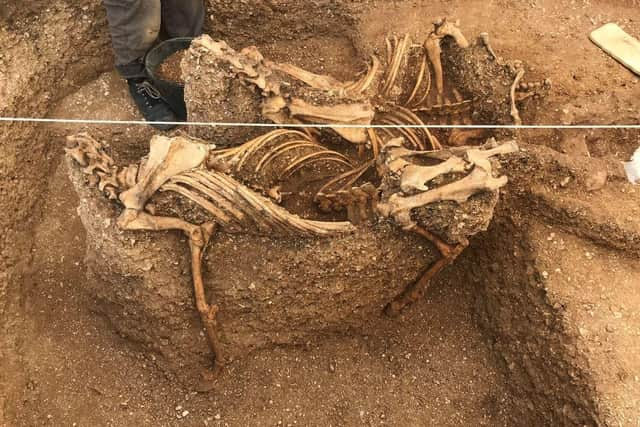Spectacular Iron Age shield found in Pocklington donated back to Yorkshire by housebuilder whose land it was discovered on
The “unique” bronze alloy shield - valued at £300,000 - was used as part of an elaborate funeral rite to lay to rest a "charismatic" leader some 2,400 years ago.
The grave, which included two ponies attached to a chariot, posed to look as if they were galloping out of the tomb – possibly to rapidly propel the man into the afterlife - was uncovered during excavations at Persimmon's site at The Mile in Pocklington in 2018.
Advertisement
Hide AdAdvertisement
Hide AdThe shield will go on display for one night only at Burnby Hall on February 23, where archaeologist Paula Ware is giving a talk, and launching Chariots, Swords and Spears, a 300-page volume detailing the finds made in digs at Burnby Lane and The Mile. It will go on display at Malton Museum in April.


Since its discovery specialists have been discovering more about the man, who was so highly valued by his community that they went to great lengths to bury him in such style.
Aged at least 46, and possibly considerably older, he’d suffered blunt force trauma to his left thigh and a broken rib which was healing at the time of his death. He only had three teeth left and his finger bones were a “bit gnarled”.
Ms Ware, managing director of MAP Archaeological Practice, said the funeral would have been a "performance" of high drama.
Advertisement
Hide AdAdvertisement
Hide AdThe mourners dug a pit 1m deep and placed the chariot upright in the grave. They placed the shield face down and put the man's body on top in a crouched position. Pork provided food for the final journey.


How the ponies got in the grave is still a mystery - there was no ramp - suggesting they may have been poleaxed in situ.
When found their heads were missing due to plough damage, but it is believed they were left sticking up above the ground as some kind of headstone.
Ms Ware said: "He was 46 plus and I would say considerably older. He only had three teeth left, his finger bones were a bit gnarled. He definitely had osteoporosis, he was above average height."
Advertisement
Hide AdAdvertisement
Hide Ad"I think he is a singular member of that community. As they were paying their respects, someone threw in a toasting fork with a complete rib of pork.


"In Iron Age culture pork is a very expensive product. Around his head there were six pig skulls. This is all part of the ritual.
"No question about it, this is a performance, like a theatre performance. The horses' rear legs are lifted off the ground as if they are about to leap out. The evidence suggests that when he was buried the heads were sticking out."
When Caesar invaded 350 years later he wrote of the natives’ incredible skill as horsemen, their ability to control them “at full gallop” and “run along a chariot pole, stand on the yoke and get back in as quick as lightening."
Advertisement
Hide AdAdvertisement
Hide Ad"He may have done that in his youth," said Ms Ware. "He has the shield and the wealth. Is he a wise man? He was really special. The evidence seems to support that they live and work with horses and are very skilled horsemen.


"They understood about the snaffle bit that we still use now."
The shield is an incredibly rare survivor – just a handful of other complete Celtic shields are in the British Museum. Although ornate, it was designed for combat, with a large central boss for “pinning or crushing an opponent".
Experts have speculated that a single stab wound in the shield was left possibly as a mark of fighting renown or was deliberately made at the time of burial.
Advertisement
Hide AdAdvertisement
Hide AdStudies of isotopes found that the man probably grew up in the Wolds, but couldn't rule out that he may have come from the Paris area in France - where the Parisi tribe are believed to have originated.
East Yorkshire is the only area of Britain in which chariot burials have been found. They’ve also been found in northern France.
The Iron Age tribes of both areas were known as Parisi and one theory is that Celtic nobles from northern France seized power in the East Riding bringing with them their own distinctive burial customs.
--
